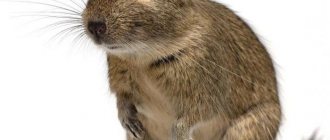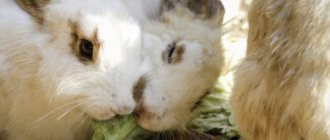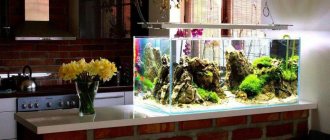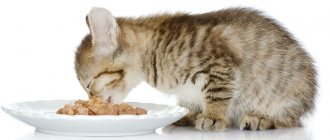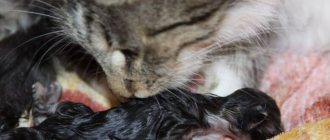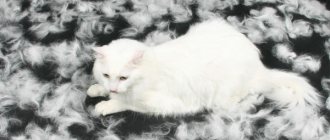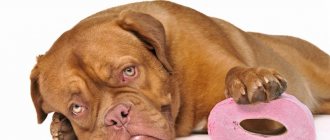general information
Zoologists classify degus as bush rats , which are mammals belonging to the order Rodents.
The body size of these animals can range from 95 to 125 mm, and weight - from 200 to 300 grams. To the full size should be added the length of the tail (6.5–10.5 cm), which is not covered with thick hair and has a small tassel at the end. The fur is gray-brown on the back and light yellow on the belly. Some degus have an orange tint to their main color.
In the wild they live in flocks of 25 to 30 individuals. The leaders of such groups are 2-3 females, to whom all the others obey unquestioningly. They live in branched burrows, in which they build nests for comfortable accommodation and breeding of offspring.
Very active and mobile. They move freely both on the ground and through tall bushes and trees. They feed only on food of plant origin .
Did you know? In direct contact with degus, you should never hold them, much less lift them by the tail. In such a situation, the animals shed the skin from their tail in order to free themselves, and subsequently gnaw it off in a safe place.
Characteristics of the Degu squirrel
Degus have a thick and short neck, a flattened nose and a small rounded head. The hind legs of the degus are longer than the front legs. The coat is hard, dense and has a yellow-brown or gray-brown color.
The Chilean squirrel can distinguish low-frequency sounds, has an excellent sense of smell, and is also able to see well up close and absolutely cannot distinguish distant objects.
Degus in the wild live only 4 years. However, with proper care and nutrition, this pet can live up to 8 years.
How many individuals are best kept together?
Degus prefer company. If the owner can pay enough attention to his pet, then the option of solitary housing is quite acceptable. The gender of the animal is not particularly important, but it should be noted that males are more sociable and easier to tame.
No special knowledge is required about how the sex of a degu is determined. It is enough to estimate the distance between the anus and the urethra. In females it is much smaller than in males.
It is acceptable to keep them in pairs, preferably of the same gender and age. In this case, the animals will definitely not be bored.
For breeding, you should create a small group of one male and several females. It should be borne in mind that it is permissible to form a pack with age restrictions, since after 4 months of age the animals are reluctant to accept new ones and can seriously conflict.
Important! Family ties should be taken into account. Keeping one litter with the prospect of mating is unacceptable, as this leads to weakened immunity in the new generation and degeneration of the breed.
How long do they live at home?
Under natural conditions, like all small rodents, degus have many enemies that feed on them. Therefore, the average life expectancy is only 3, maximum 4 years, and only 1% of the total number of newborns survive to this age.
But how long degus will live at home directly depends on the health of the animals, the quality of food and environmental influences. With careful care, a safe and comfortable living environment, and proper nutrition, they live from 5 to 9 years. But it should be understood that nine years of age for a degu is the same as 120 years of life for a person.
Find out which cage is best for your hamster and how to set it up.
How to determine the age of a degu?
You can find out the real age of a degu by its weight. An adult degu weighs about 200 g and is about the size of a rat. If it is a baby, then it is slightly larger than a mouse.
Keep in mind that newborn degus weigh about 6-7 g. Babies become independent at the age of several weeks, and sexually mature at 2-3 months. By this age, their weight can reach 50–100 g.
You can also determine the age of a degu by the pads on its hind legs. If the skin on the foot is shiny, then this means a young animal (up to a year). Horny skin and calluses on the heel indicate the mature age of the animal. An older animal has calluses under its toes as well.
How to determine the age of a degu by its behavior? Old individuals will look somewhat apathetic and lethargic. They do not express much activity. Young animals, on the contrary, play happily and constantly frolic. In addition, the eyes of old animals lose their shine and become dull. With age, the degu's coat also thins out significantly, its color fades, and it gradually becomes much lighter.
You can also approximately determine the age of a degu by the color of its teeth. As they age, their color changes from orange to brown.
Experienced degu owners can easily determine the approximate age of their pet. First of all, they pay attention to the coat, which in young degus should lie close to the body; the animal must also have a uniform layer of fat. An old animal has too thin a layer of fat on its back, which is why the spine protrudes even with good feeding and care.
Some future owners, before buying a pet, wondering how to find out the age of a degu, forget about the physiological characteristics of the animal, which also help determine its age. Thus, the degu reaches its maximum size at the age of about a year. The average lifespan of an animal is 5 – 8 years. Degus are social creatures, so you should buy them at the age of more than 3-4 months (adolescents), when they are already striving for independence, and not at 5-6 weeks (children), as they often try to sell in a pet store.
Also, when choosing an adult degu, pay attention to its teeth. In old age, these animals, as a rule, may have problems with their incisors, which grow too much; their front surface is covered with fairly strong enamel, but there is no such coating on the back, so the incisors there wear away much faster, and the tooth takes on the shape of a chisel.
Choosing and arranging a home
One or a pair of rodents should be kept in a fine-mesh metal cage with a minimum length, width and height of 600x450x400 mm. Despite the small size of the animals, they require a large, preferably multi-tiered space.
Some owners prefer glass terrariums of the same volume, with a lattice on top.
The standard housing layout for degus, which simplifies care and improves maintenance at home, is as follows:
- bedding made of wood shavings, compressed corn cobs or clean paper;
- in the corner there is a small house in which a nest will be created;
- on the opposite side there is a tray with sand for swimming;
- between them there are clay pots, large branches, stones;
- there are several shelves on the walls located at different heights;
- freely rotating squirrel wheel;
- several bowls for various foods;
- drinking bowl
Large branches and tree roots are a must, as rodents constantly need to sharpen their teeth. Various kinds of objects, obstacles, crossbars and shelves are necessary for active and interesting pastime for animals.
Important! The cage should be installed in a place where there are no drafts or direct sunlight.
What do they eat
There are usually no problems with what to feed the Chilean degu squirrel. But when creating a menu for your pet, you need to consider the following points :
- the diet should contain only plant foods, since these animals are exclusively herbivores;
- Do not feed vegetables and fruits high in sugar, as this can lead to diabetes.
In order to have no doubt about proper nutrition, you can use ready-made food from manufacturers such as Beaphar, Vitakraft or Versele-laga. These foods have a balanced content of all nutrients, microelements and vitamins that rodents need.
A mandatory year-round feed is high-quality hay, which can be replaced in summer with freshly cut grass or other succulent feed. The temporary transition to succulent food is carried out gradually, starting with small portions. Alfalfa, clover, and lettuce are suitable as delicacies.
Grain mixtures of oats, wheat, barley, and millet are well accepted by rodents. Acceptable solid foods include bark and branches of willow, linden, apple, and pear trees.
In small quantities, it is acceptable to feed dried fruits of unsweetened varieties of apples and pears, as well as carrots cut into small pieces.
Infrequently and in small quantities, it is possible to use hawthorn and rose hips, chokeberry, corn grains, pumpkin or sunflower seeds. Typically, such foods are suitable for taming animals.
Care and communication
Caring for the Chilean squirrel is extremely simple. You should remove leftover food, clean the bedding and wash the feeders daily. Clean the cage weekly and disinfect it monthly.
There is no need to do anything with the animal itself, since its fur is cleaned during bathing in special sand. Teeth and claws wear down naturally when they chew on wooden objects and actively move around the cage.
The guinea pig is a very friendly animal, it loves attention and enjoys sitting in your arms, “purring” when stroked.
The task of teaching a degu to hold hands, respond to a name and follow simple commands is not difficult. First of all, it is necessary to convince the animal that it is absolutely safe . To do this, you do not need to talk loudly or make sudden movements. In the future, placing a small amount of treats on the palm of your hand, switch to direct contact. The animal itself will come up and take the treat from your hand. Having the highest level of intelligence among rodents, degus quickly understand what is wanted of them. When handled carefully and gently, they are happy to communicate with people, despite their restless nature.
Did you know? If a person studies the sounds that degus make in certain situations, and then begins to imitate them, then the animals will understand him. For example, a certain whistle denotes danger. Therefore, by whistling in the right key, a rodent can be driven away from an electrical cable or valuable furniture, which it wants to taste while walking around the apartment.
How to make your pet happy?
According to reviews, the degu is unpretentious in care and protein content, however, there are certain factors that can make it truly happy:
- Delicious food is almost half the success. When kept at home, caring for the Chilean degu squirrel will be correct, provided that a large amount of food is always available. Since the rodent is an agricultural pest that destroys crops, it needs a lot of dry food to be completely happy. This includes hay, dried herbs, and various grains.
- A large enclosure will give your pet joy every day. Look at the numerous photos: there is nothing complicated in caring for and maintaining a degu squirrel, and to be happy, it is enough for her to have her own multi-story house. Two or three levels separated by stairs, ropes, running wheels and other obstacles that the animal will happily overcome every day.
- When caring for and maintaining a degu at home, it is important to remember that cleanliness means a lot to it. Try to pay special attention to this aspect. If you can't find a cage with a double bottom, change the bedding as often as possible. Keep it clean and remove scraps promptly. As a last resort, in order to avoid traces and smell of urine, you can use wood cat litter.
Hygiene procedures
Degus, being very clean animals, clean and degrease their fur on their own using the dry cleaning . Bathing procedures are ensured by placing a deep tray or bath with special sand in the cage every day for bathing.
To avoid the occurrence of an unpleasant odor, it is necessary to remove any leftover food every day and periodically change the bedding in areas of contamination. A complete replacement should not be carried out, since rodents are very sensitive to changes in the environment. The bedding's own scent, which permeates the litter over time, calms the animals.
We advise you to read about the features of keeping and breeds of decorative rabbits.
Mandatory events
Once or twice a day, the pet must be released from the enclosure. Let him run around and satisfy his curiosity to the fullest. However, it is advisable to fence off the area so that the squirrel cannot get hurt or accidentally jump out into the street. Make sure that glassware and electrical wiring are inaccessible, and that windows and vents are tightly closed. In addition, some plants can be dangerous for these animals: sansevieria, ivy, anthurium, etc. If you have such indoor flowers, then it is better to take them out of the room first.
There is no need to bathe your degu. It is worth noting that these rodents are extremely clean and are able to independently take care of their own hygiene. To do this, just place a small container of sand in their cage. This unique bathhouse is changed daily.
Leftover food and wet litter must be removed every day. The litter is cleaned weekly, and general cleaning is carried out once a month. In this case, the tray is first washed with laundry soap, then wiped dry and covered with clean, dry paper, and only then filler is poured.
